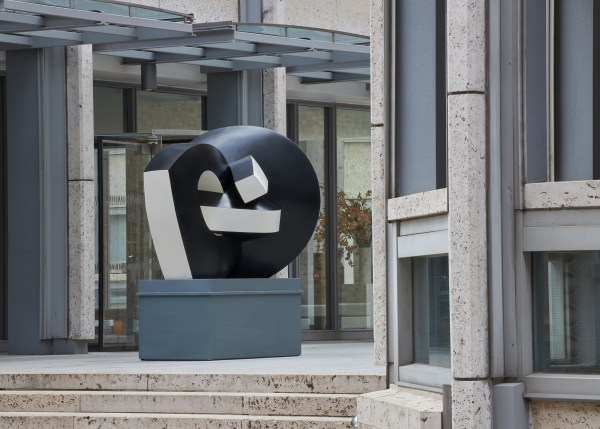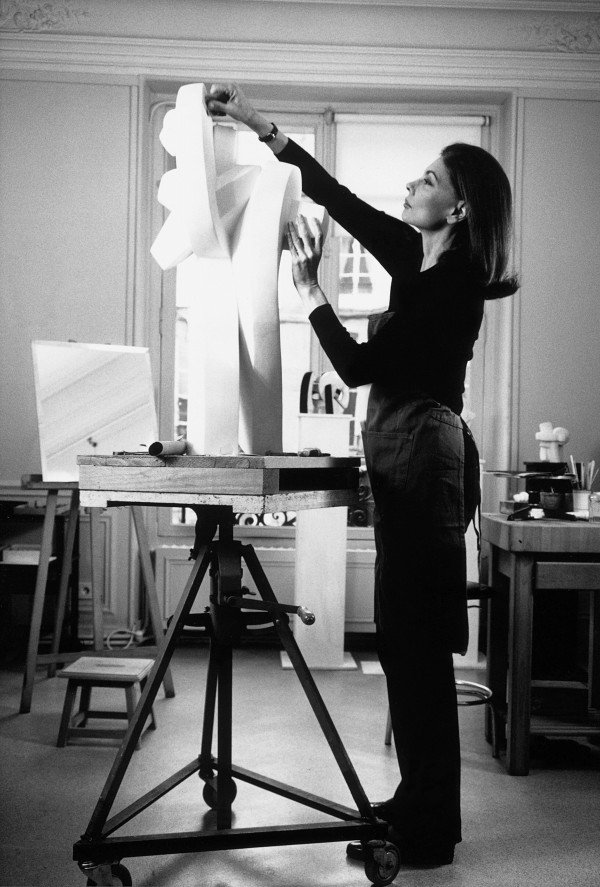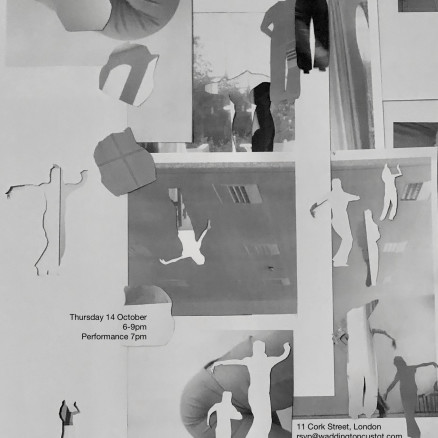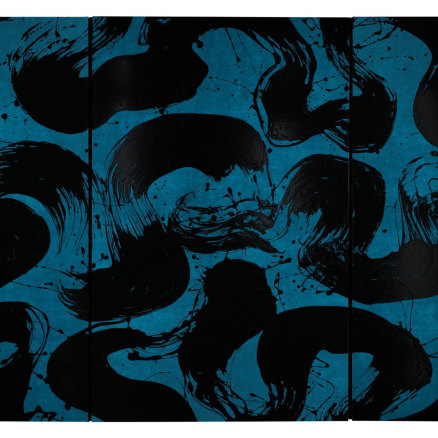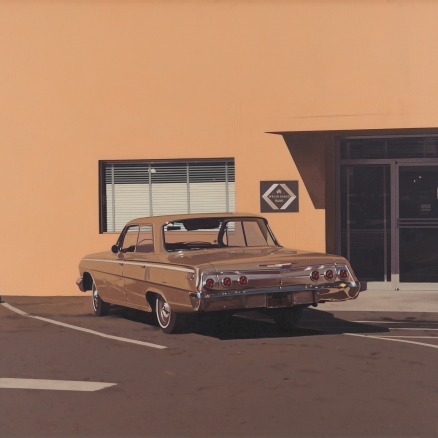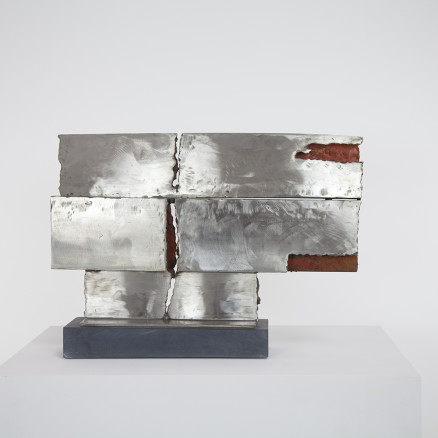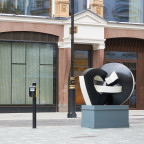Biography
Sophia Vari (née en 1940 à Athènes, Grèce ; décédée en 2023 à Monte Carlo, Monaco) est célèbre pour le langage visuel distinct et cohérent à travers lequel elle a étudié le volume, la forme et l'équilibre abstraits. Travaillant à travers la sculpture, le collage, l'huile et l'aquarelle, Vari a soigneusement navigué diverses influences, des traditions artistiques olmèques et cycladiques au modernisme européen, dans sa volonté constante d'exprimer « la beauté et l'harmonie ».
Née à Athènes d'un père grec et d'une mère hongroise, Vari passe une partie de son enfance en Suisse, étudie ensuite en Angleterre puis à Paris, où elle se familiarise avec les mouvements de l'art moderne, notamment le cubisme et le surréalisme. Elle est diplômée de l'École des Beaux-Arts de Paris en 1958 et réalise principalement des peintures figuratives tout au long des années 1960 et au début des années 1970. Au milieu des années 1970, Vari s'est intéressée à l'expression de ses idées dans un autre médium et, lors d'un voyage en Égypte, elle a compris l'importance de la sculpture monumentale. Après avoir épousé en 1978 le peintre et sculpteur colombien de renommée internationale Fernando Botero, qui avait quitté New York pour Paris en 1973, Vari a commencé à faire des recherches sur l'art précolombien. Inspirée par cet art indigène des Amériques du Nord, Centrale et du Sud, en particulier les formes stylisées de la sculpture olmèque, Vari commence à abstraire sa ligne, en utilisant des formes arrondies épurées pour suggérer le corps humain. En 1992, elle ouvre un atelier à Paris où elle réalise ses propres œuvres et enseigne à de jeunes artistes. Continuant à explorer l'abstraction, au milieu des années 1990, Vari atteint le zénith de son langage visuel, incorporant des formes planaires dans son travail et appliquant de la couleur aux surfaces de ses sculptures. Cette utilisation de la couleur contribue au dynamisme des pièces de Vari, et ses œuvres sculpturales, créées à une échelle monumentale et comme pièces de table, semblent bouger lorsque le spectateur se promène autour d'elles.
Les sculptures monumentales de Vari ont été exposées publiquement dans des villes du monde entier, notamment à Paris, Rome, Monte-Carlo, Baden-Baden, Genève, Pietrasanta, Athènes et Madrid. En 2022, trois sculptures importantes ont été exposées sur la Smithson Plaza à Londres et plus récemment, de mai à novembre 2023, 12 pièces monumentales ont été exposées le long de Park Avenue à New York. Reconnue pour avoir présenté plus de 100 expositions individuelles au cours de sa carrière, les expositions institutionnelles importantes du travail de Vari comprennent celles du Palazzo Vecchio de Florence ; Palais Bricherassio, Turin ; Le Musée Ludwig, Coblence, France ; et le Musée Pera à Istanbul. Le travail de Vari fait partie de collections publiques internationales, notamment du musée Beelden aan Zee, La Haye ; Musée Benaki, Athènes ; Fondation Veranneman, Kruishoutem, Belgique ; Fondation Basil et Elise Goulandris : Musée d'Art Moderne, Andros, Grèce ; Fundaçao Calouste Gulbenkian, Lisbonne ; Fondation Botero, Bibliothèque Luis Angel Arango, Bogota ; Musée de la Main, Lausanne ; Musée de Medellin, Medellin, Colombie ; Musée de Ponce, Porto Rico ; Musée national et Musée Alexandros Soultzos, Athènes ; Pinacothèque nationale, Athènes.
Lire plusŒuvres
-
 Sophia Vari, Pleine Lune, 2022
marble
13 1/4 x 11 5/8 x 11 in
33.5 x 29.5 x 28 cm
%3Cdiv%20class%3D%22artist%22%3E%3Cspan%20class%3D%22artist%22%3E%3Cstrong%3ESophia%20Vari%3C/strong%3E%3C/span%3E%3C/div%3E%0D%3Cdiv%20class%3D%22title%22%3E%3Cem%3EPleine%20Lune%3C/em%3E%2C%202022%3C/div%3E%0D%3Cdiv%20class%3D%22medium%22%3Emarble%3Cbr%20/%3E%0A%3C/div%3E%0D%3Cdiv%20class%3D%22dimensions%22%3E13%201/4%20x%2011%205/8%20x%2011%20in%3Cbr%20/%3E%0A33.5%20x%2029.5%20x%2028%20cm%3C/div%3E
Sophia Vari, Pleine Lune, 2022
marble
13 1/4 x 11 5/8 x 11 in
33.5 x 29.5 x 28 cm
%3Cdiv%20class%3D%22artist%22%3E%3Cspan%20class%3D%22artist%22%3E%3Cstrong%3ESophia%20Vari%3C/strong%3E%3C/span%3E%3C/div%3E%0D%3Cdiv%20class%3D%22title%22%3E%3Cem%3EPleine%20Lune%3C/em%3E%2C%202022%3C/div%3E%0D%3Cdiv%20class%3D%22medium%22%3Emarble%3Cbr%20/%3E%0A%3C/div%3E%0D%3Cdiv%20class%3D%22dimensions%22%3E13%201/4%20x%2011%205/8%20x%2011%20in%3Cbr%20/%3E%0A33.5%20x%2029.5%20x%2028%20cm%3C/div%3E -
 Sophia Vari, Constellation, 2021
marble
29.5 x 28 x 22 cm
Sophia Vari, Constellation, 2021
marble
29.5 x 28 x 22 cm
-
 Sophia Vari, Pas de Danse, 2016
silver
11 7/8 x 5 1/8 x 5 1/8 in
30 x 13 x 13 cm
%3Cdiv%20class%3D%22artist%22%3E%3Cspan%20class%3D%22artist%22%3E%3Cstrong%3ESophia%20Vari%3C/strong%3E%3C/span%3E%3C/div%3E%0D%3Cdiv%20class%3D%22title%22%3E%3Cem%3EPas%20de%20Danse%3C/em%3E%2C%202016%3C/div%3E%0D%3Cdiv%20class%3D%22medium%22%3Esilver%3C/div%3E%0D%3Cdiv%20class%3D%22dimensions%22%3E11%207/8%20x%205%201/8%20x%205%201/8%20in%20%3Cbr%20/%3E%0A30%20x%2013%20x%2013%20cm%3C/div%3E%0D%3Cdiv%20class%3D%22edition_details%22%3Ecast%20number%202%20from%20an%20edition%20of%206%20plus%202%20APs%3C/div%3E
Sophia Vari, Pas de Danse, 2016
silver
11 7/8 x 5 1/8 x 5 1/8 in
30 x 13 x 13 cm
%3Cdiv%20class%3D%22artist%22%3E%3Cspan%20class%3D%22artist%22%3E%3Cstrong%3ESophia%20Vari%3C/strong%3E%3C/span%3E%3C/div%3E%0D%3Cdiv%20class%3D%22title%22%3E%3Cem%3EPas%20de%20Danse%3C/em%3E%2C%202016%3C/div%3E%0D%3Cdiv%20class%3D%22medium%22%3Esilver%3C/div%3E%0D%3Cdiv%20class%3D%22dimensions%22%3E11%207/8%20x%205%201/8%20x%205%201/8%20in%20%3Cbr%20/%3E%0A30%20x%2013%20x%2013%20cm%3C/div%3E%0D%3Cdiv%20class%3D%22edition_details%22%3Ecast%20number%202%20from%20an%20edition%20of%206%20plus%202%20APs%3C/div%3E -
 Sophia Vari, Continuité, 2006
bronze
42.5 x 39 x 36 cm
Sophia Vari, Continuité, 2006
bronze
42.5 x 39 x 36 cm
-
 Sophia Vari, Trouble essentiel, 2005
marble
46 x 66 x 44 cm
Sophia Vari, Trouble essentiel, 2005
marble
46 x 66 x 44 cm
-
 Sophia Vari, La Reine, 2000
bronze polychrome black and white
118 1/8 x 54 3/8 x 35 1/2 in
300 x 138 x 90 cm
%3Cdiv%20class%3D%22artist%22%3E%3Cspan%20class%3D%22artist%22%3E%3Cstrong%3ESophia%20Vari%3C/strong%3E%3C/span%3E%3C/div%3E%0D%3Cdiv%20class%3D%22title%22%3E%3Cem%3ELa%20Reine%3C/em%3E%2C%202000%3C/div%3E%0D%3Cdiv%20class%3D%22medium%22%3Ebronze%20polychrome%20black%20and%20white%3C/div%3E%0D%3Cdiv%20class%3D%22dimensions%22%3E118%201/8%20x%2054%203/8%20x%2035%201/2%20in%3Cbr%20/%3E%0A300%20x%20138%20x%2090%20cm%3C/div%3E
Sophia Vari, La Reine, 2000
bronze polychrome black and white
118 1/8 x 54 3/8 x 35 1/2 in
300 x 138 x 90 cm
%3Cdiv%20class%3D%22artist%22%3E%3Cspan%20class%3D%22artist%22%3E%3Cstrong%3ESophia%20Vari%3C/strong%3E%3C/span%3E%3C/div%3E%0D%3Cdiv%20class%3D%22title%22%3E%3Cem%3ELa%20Reine%3C/em%3E%2C%202000%3C/div%3E%0D%3Cdiv%20class%3D%22medium%22%3Ebronze%20polychrome%20black%20and%20white%3C/div%3E%0D%3Cdiv%20class%3D%22dimensions%22%3E118%201/8%20x%2054%203/8%20x%2035%201/2%20in%3Cbr%20/%3E%0A300%20x%20138%20x%2090%20cm%3C/div%3E -
 Sophia Vari, Le Roi, 2000
bronze polychrome black and white
122 x 55 7/8 x 38 5/8 in
310 x 142 x 98 cm
%3Cdiv%20class%3D%22artist%22%3E%3Cspan%20class%3D%22artist%22%3E%3Cstrong%3ESophia%20Vari%3C/strong%3E%3C/span%3E%3C/div%3E%0D%3Cdiv%20class%3D%22title%22%3E%3Cem%3ELe%20Roi%3C/em%3E%2C%202000%3C/div%3E%0D%3Cdiv%20class%3D%22medium%22%3Ebronze%20polychrome%20black%20and%20white%3C/div%3E%0D%3Cdiv%20class%3D%22dimensions%22%3E122%20x%2055%207/8%20x%2038%205/8%20in%3Cbr%20/%3E%0A310%20x%20142%20x%2098%20cm%3C/div%3E
Sophia Vari, Le Roi, 2000
bronze polychrome black and white
122 x 55 7/8 x 38 5/8 in
310 x 142 x 98 cm
%3Cdiv%20class%3D%22artist%22%3E%3Cspan%20class%3D%22artist%22%3E%3Cstrong%3ESophia%20Vari%3C/strong%3E%3C/span%3E%3C/div%3E%0D%3Cdiv%20class%3D%22title%22%3E%3Cem%3ELe%20Roi%3C/em%3E%2C%202000%3C/div%3E%0D%3Cdiv%20class%3D%22medium%22%3Ebronze%20polychrome%20black%20and%20white%3C/div%3E%0D%3Cdiv%20class%3D%22dimensions%22%3E122%20x%2055%207/8%20x%2038%205/8%20in%3Cbr%20/%3E%0A310%20x%20142%20x%2098%20cm%3C/div%3E -
 Sophia Vari, Trouble Essentiel, 1993
bronze
55 1/8 x 72 1/2 x 47 1/4 in
140 x 168 x 120 cm
%3Cdiv%20class%3D%22artist%22%3E%3Cspan%20class%3D%22artist%22%3E%3Cstrong%3ESophia%20Vari%3C/strong%3E%3C/span%3E%3C/div%3E%0D%3Cdiv%20class%3D%22title%22%3E%3Cem%3ETrouble%20Essentiel%3C/em%3E%2C%201993%3C/div%3E%0D%3Cdiv%20class%3D%22signed_and_dated%22%3Ecast%20number%202%20from%20an%20edition%20of%203%20plus%202%20APs%3C/div%3E%0D%3Cdiv%20class%3D%22medium%22%3Ebronze%3Cbr%20/%3E%0A%3C/div%3E%0D%3Cdiv%20class%3D%22dimensions%22%3E55%201/8%20x%2072%201/2%20x%2047%201/4%20in%3Cbr%20/%3E%0A140%20x%20168%20x%20120%20cm%3C/div%3E
Sophia Vari, Trouble Essentiel, 1993
bronze
55 1/8 x 72 1/2 x 47 1/4 in
140 x 168 x 120 cm
%3Cdiv%20class%3D%22artist%22%3E%3Cspan%20class%3D%22artist%22%3E%3Cstrong%3ESophia%20Vari%3C/strong%3E%3C/span%3E%3C/div%3E%0D%3Cdiv%20class%3D%22title%22%3E%3Cem%3ETrouble%20Essentiel%3C/em%3E%2C%201993%3C/div%3E%0D%3Cdiv%20class%3D%22signed_and_dated%22%3Ecast%20number%202%20from%20an%20edition%20of%203%20plus%202%20APs%3C/div%3E%0D%3Cdiv%20class%3D%22medium%22%3Ebronze%3Cbr%20/%3E%0A%3C/div%3E%0D%3Cdiv%20class%3D%22dimensions%22%3E55%201/8%20x%2072%201/2%20x%2047%201/4%20in%3Cbr%20/%3E%0A140%20x%20168%20x%20120%20cm%3C/div%3E -
 Sophia Vari
artist at her work in her atelier, 2016
Sophia Vari
artist at her work in her atelier, 2016
-
 Sophia Vari, artist in her studio
Courtesy the artist.
Sophia Vari, artist in her studio
Courtesy the artist.
Dernières

















